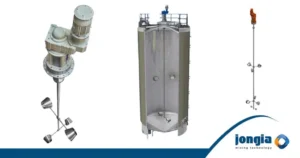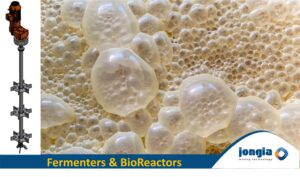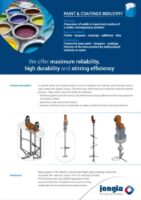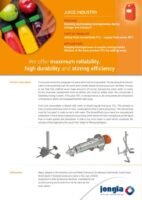Jongia Mixing Technology has initiated many mixing processes worldwide with its agitators. In some of these mixing processes, the elimination of foam that can arise from the behavior of the recipe is essential as well. Because when foaming can be avoided, the stirring process will run much more smoothly, greatly reducing production times!
Foaming in the mixing process
In many applications, foaming is an unavoidable side-effect of stirring processes, for example when mixing at high speeds and when mixing powders. The higher the agitator mixing element speed, the better the mixing effect. However, this also increases the amount of foam which can then lead to more air entering the liquid.
Next to that, often a decisive factor in foaming is the presence of additives that can even aggravate it. However, these substances usually have an essential function in the recipe and are therefore indispensable in the process.
Importance of the right agitator
Although the chance of foaming exists, its effect can certainly be controlled or at least minimized. To this end, choosing the right agitator mixing element is essential. After all, excessive foaming can seriously disrupt the mixing process as it can lead to longer cycle times, difficulty in recipe handling, lower productivity, product loss, and extensive cleanup.
Additionally, trapped air left in the recipe can cause structural problems, cloudiness, discoloration, voids, instability, and other undesirable characteristics. It certainly has a major impact on the final product.
There are of course certain anti-foaming agents that one can add to prevent or even eliminate foam. However, these come with their own disadvantages. The main disadvantages of using anti-foaming agents are the high cost and the fact that in some products these can negatively affect the recipe of the product.
The best way to avoid using chemical defoamers
Below are some simple steps that can prevent or greatly reduce foaming:
Reducing the vortex that can occur from the agitator mixing element;
- Reducing the speed of the agitator as soon as the agitator mixing element and the liquid level get too close to each other;
- Proper positioning of the Top-entry agitator in the tank;
- Proper positioning of the Side-entry agitator in the tank;
- The selection of the agitator mixing element itself can have a major impact on foaming.
Based on the above list it can be said that an agitator manufacturer should give the right advice when it comes to preventing foaming. This does need to be based on the correct input of data that is available or can be experienced via a test setup.
Jongia Mixing Technology has extensive experience in various situations where the prevention of foam has been of great importance for the reduction of production times in stirring processes, or even for preventing the selection of extra-large tank volumes to accommodate for the foam. Such savings indicate that a specialist like Jongia can best advise your process.
Want to know more?
As with all products to be mixed, preventing or reducing foaming certainly requires a specific approach. Jongia Mixing Technology has all the knowledge and experience to provide you with comprehensive product advice. Do you have any questions? Please do not hesitate to contact us.
Contact our specialized team for all your questions

Tom Pruymboom
Sales Director
Area Worldwide

Bart Brouwer
Area Sales Manager
Area Worldwide
Technical Questions?

Sijko van der Veen
Application Engineer
Technical Specialist

Sijko van der Veen
Application Engineer
Technical Specialist
Related Articles

Do I need a Bottom Bearing for my agitator?
Do I need a Bottom Bearing? The installation of a bottom bearing is not mandatory. While it offers certain advantages, there are also drawbacks to consider. It is important to note that the bottom bearing functions more as a displacement

Homogenization and Cooling in Diary Cream Production
Utilizing Jongia’s Cup Mixer Homogenization is a standard procedure employed in dairy cream production to ensure the consistent distribution of fat globules in both milk and cream. This process, achieved through a high-pressure homogenization apparatus, breaks down and disperses fat

Fermentation & Bioreactor Mixing Process
Bioreactors and Fermenters are culture systems to produce cells or organisms. They are used in various applications, including basic research and development, and the manufacturing of biopharmaceuticals, food and food additives, chemicals, and other products. A broad range of cell types and organisms can be cultivated in bioreactors and Fermenters, including cells (like mammalian cell lines, insect cells, and stem cells), microorganisms (like bacteria, yeasts, and fungi), as well as plant cells and algae. The words “Bioreactor” and “Fermenter” are basically the same thing.






